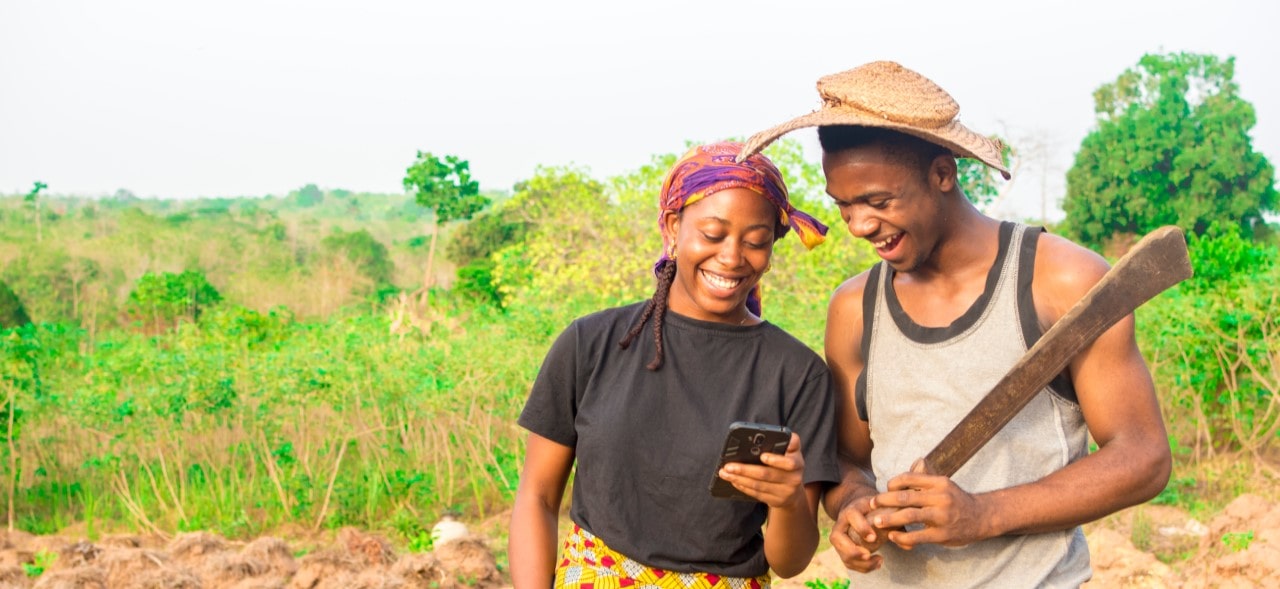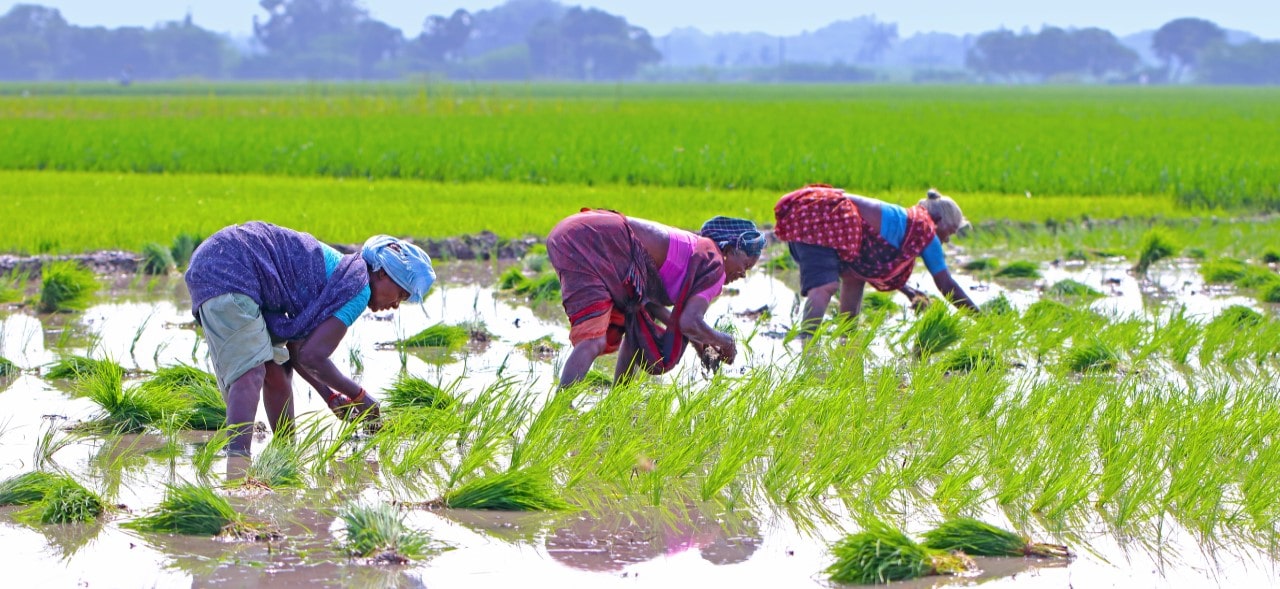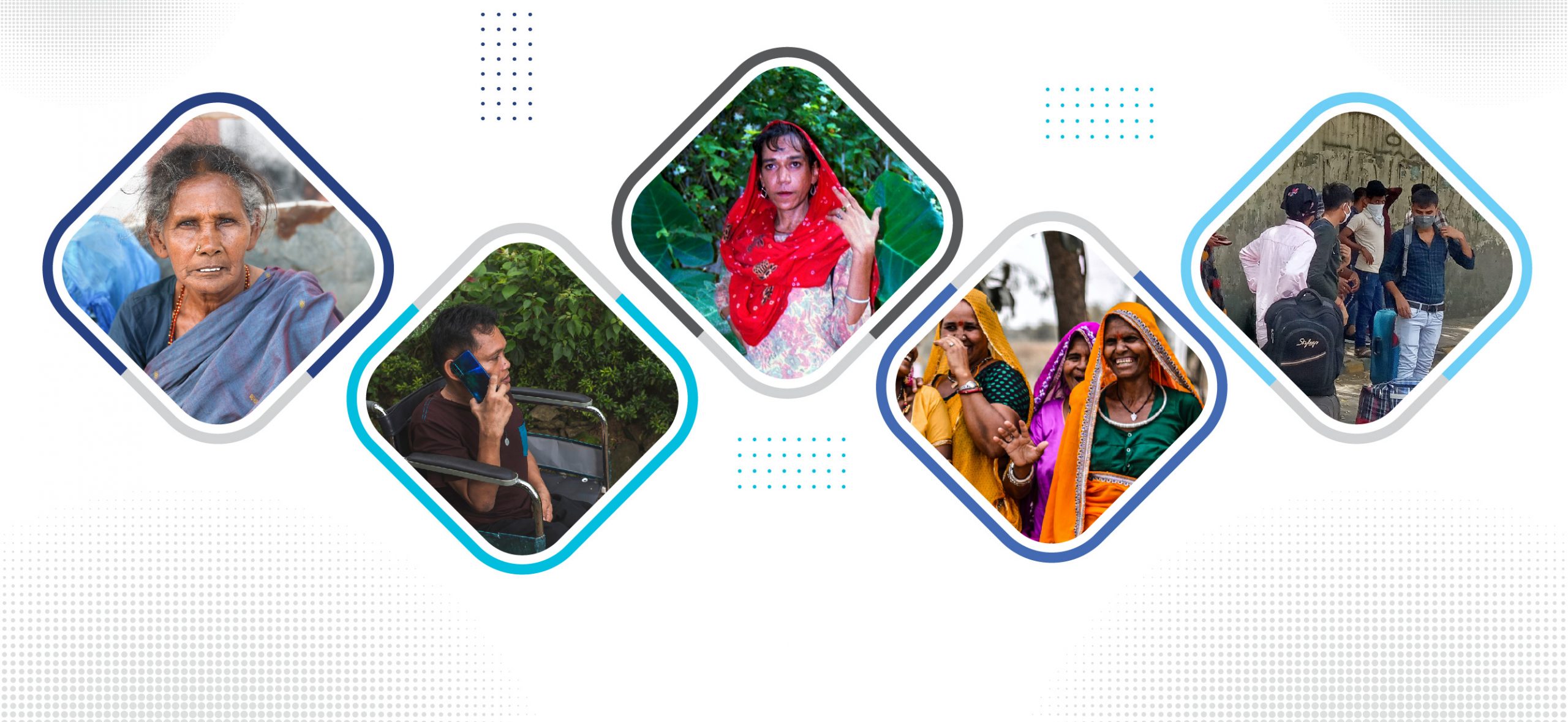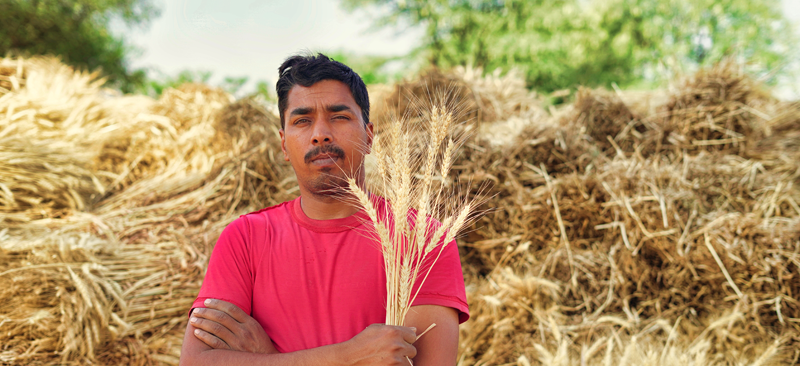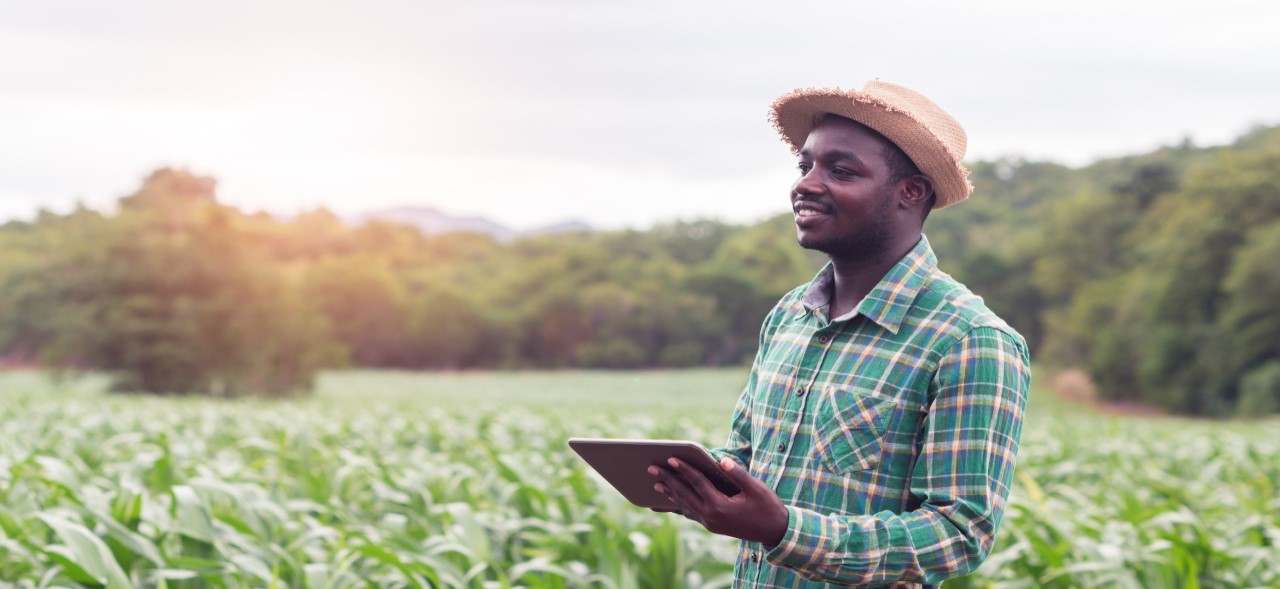In developing nations, underserved people rely on agriculture, livestock, forestry, and allied activities for livelihoods. However, these sectors still struggle with technological advancements, particularly in digitalization. Innovations like AI/ML, blockchain, IoT, and large language model-based applications have emerged, but they face challenges like fragmented solutions, inadequate collaboration, and lack demand-driven reach. Initiatives like the AgriStack program and Integrated Digital Farmer Services Platform in India can help overcome these barriers.
Blog
Climate Resilient Agriculture (CRAg) Whitepaper
Various digital solutions have emerged as potential game-changers in how the agri-food market functions and productivity-enhancing solutions are delivered. What constrains the potential of these innovations? If we take a systems perspective on the agri-food sector, we must consider three broad inter-related aspects:
- Integration and coordination in value chains
- Diffusion of innovation across value chain participants
- Financing innovation end-to-end
If these solutions are to be effective, actors in the development sector need to mobilize a strong collective effort. They should determine how to harness digital technology to address the practical problem of change—many of which fall within the locus of these three areas. Finding viable routes to financing potential transformation pathways to resilience will be decisive.
Indian Post Payments Bank: Building an inclusive world
The support is divided into four workstreams: (i) an active, efficient, and capable CICO network; (ii) a suitable product for underserved segments; (iii) streamlined G2P and bulk payment processes; and (iv) a comprehensive ecosystem of merchants to drive digital transactions.
MSC’s support has helped IPPB grow and increase its revenue by 140% in the past three years, from FY 2020 to FY 2023. Such impressive growth and significant contribution to financial inclusion (47% of all accounts are women’s accounts) have attracted attention from across the globe.
The IPPB model offers many lessons postal banks can replicate in other developing countries. Delegates, including the Bill & Melinda Gates Foundation Co Chairs and visitors from 25 countries, such as Africa and South Asia, have recently visited IPPB financial camps. They showed a keen interest in IPPB’s low-cost distribution strategy supported by robust technological solutions.
IPPB was launched in 2018 to provide accessible and affordable banking services to every household in the country. Since then, IPPB has used India Post’s extensive and trusted network of 155,000+ post offices and 129,000+ postal agents (GDS) to deliver banking and payment services. Thanks to its extensive network, the IPPB now reaches underserved and unbanked customer segments at their doorstep.
Inclusive Social Protection: Mitigating Exclusion of Vulnerable Populations
In a world striving for a brighter future, where no one is left behind, access to social protection becomes a crucial lifeline. It serves as the key that unlocks the doors to ending poverty, achieving universal health coverage, and reducing inequality by 2030, as outlined in the Sustainable Development Goals (SDGs).
Governments and regulators worldwide have recognized the power of social protection programs (SPPs) as instruments to uplift impoverished populations and combat the effects of inequality. Governments worldwide have planned or implemented more than 1,100 social protection programs, which cumulatively benefit more than 1.8 billion people who have been ravaged by COVID-19.
However, even with these efforts, the most vulnerable groups still remain overlooked. Homeless individuals, differently-abled people, transgender communities, indigenous populations, and migrants often find themselves excluded from the safety net these programs should provide. Shockingly, only one in three people with severe disabilities worldwide receive disability benefits, and a mere 23% of migrants possess any form of social security documentation. Clearly, these vulnerable groups, especially women, are in dire need of social protection payments.
This blog is an attempt to shed light on the major challenges these marginalized populations face when accessing social protection programs in developing countries, such as India, Indonesia, and Bangladesh. Read on to explore recommendations to address these obstacles and design targeted interventions that ensure social protection becomes a reality for those who need it most, and in the process, create a fairer, more equitable world for all.
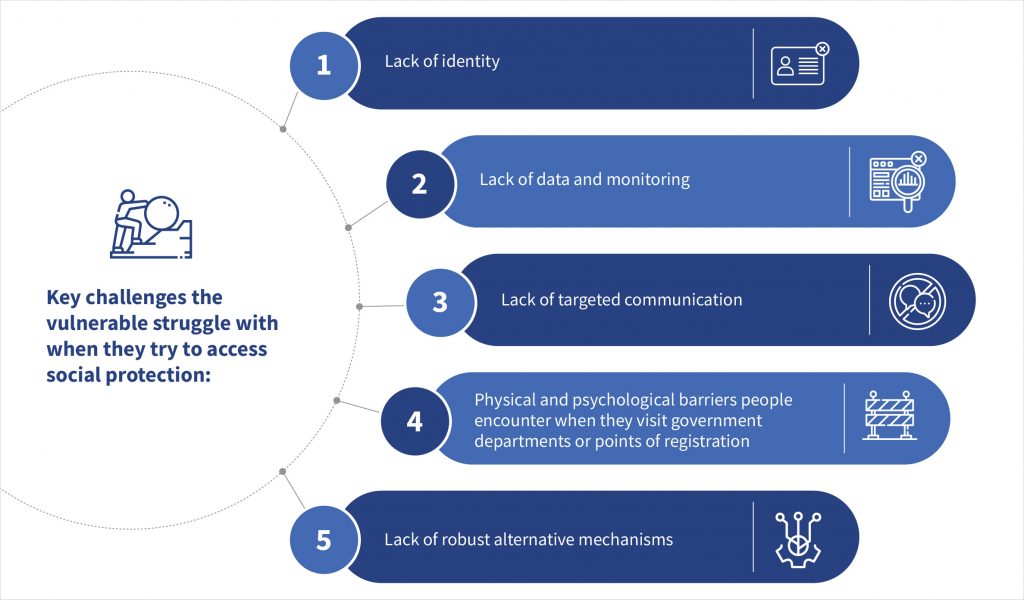
Key challenges the vulnerable struggle with when they try to access social protection:
1. Lack of identity
A substantial hurdle vulnerable populations face is the lack of proper citizenship documents to establish their identity. These groups cannot apply for social protection benefits without formal identity proof. For instance, the 2019 State of Aadhaar report found that 27% of transgender people in India lack an Aadhaar (digital identity). This is problematic for a country that otherwise succeeded in expanding Aadhaar, as around 99.9% of residents have an Aadhaar card. Similarly, discrimination against transgender people is prevalent in Indonesia, as they are often excluded[1] from government safety net programs due to a lack of national identity (KTP).[2]
Other vulnerable groups, such as homeless people, have the most acute need for food security, health, and shelter assistance. Yet they are excluded from their entitlement as they lack identity documents. When subsidized or free services, such as basic education, health, and food security are offered only after the identity verification of individuals, it is a worrying aspect that the majority of the most excluded and marginalized still face bottlenecks in establishing their identity.
2. Lack of data and monitoring
Without identity documents, any credible data on vulnerable groups and monitoring their inclusion in social protection programs proves challenging. Many governments in developing countries, including India, Indonesia, and Bangladesh, have created social registries to automatically include the targeted population groups in the social protection programs. However, the most excluded groups remain outside these databases and must visit the government offices several times to register for a new program.
3. Lack of targeted communication
Communication on various programs and policies available for vulnerable groups is weak and poorly targeted. Most governments do not direct or customize awareness-building efforts for vulnerable communities, which leads to exclusion and reduced opportunities for direct engagements with the government. In particular, indigenous groups, differently-abled people, migrants, and homeless people are more susceptible to missing out on critical information on the social assistance they are eligible to receive.
People from these vulnerable groups often lack access to communication mediums, such as television, radio, internet, and phones, which further deprives them of information from the government. For instance, despite a robust social assistance package announced by the Indian government during the COVID-19 outbreak, the 1.7 million homeless people in India faced significant challenges in receiving them. Ironically, states with 60% of India’s homeless population did not even announcing the relief measures.
4. Physical and psychological barriers people encounter when they visit government departments or points of registration
Vulnerable communities, such as transgender people, often face exclusion and harassment from society, which compels them to shy from government offices. The last-mile workers at public offices and financial institutions are not sensitized to deal with such vulnerable groups, which often leads to their mistreatment.
A study conducted by the Indonesian Puzzle Community with transgender people in 2020 revealed 84.2% of respondents had a poor experience accessing public services as they lacked ID cards. People from such groups also struggle with barriers related to culture, norms, fear, and geographical location that further restrict their access to SPPs.
5. Lack of robust alternative mechanisms
Governments have created alternative solutions for vulnerable people to ensure they do not miss their entitlements even when they fail to meet the documentation-related conditions. However, the design of such alternative mechanisms often fails to address fundamental issues.
For instance, as part of their thrust on digitization, most governments in developing countries extend social protection by transferring cash into bank accounts or mobile money wallets. However, homeless people and tribal groups are excluded as they largely lack accounts or wallets. During the COVID-19 outbreak, the Indian and Bangladeshi governments announced cash assistance. Yet these did not reach homeless people because they lacked bank accounts.
Policy changes and interventions that need consideration to reduce the exclusion of the most marginalized and vulnerable in social protection programs
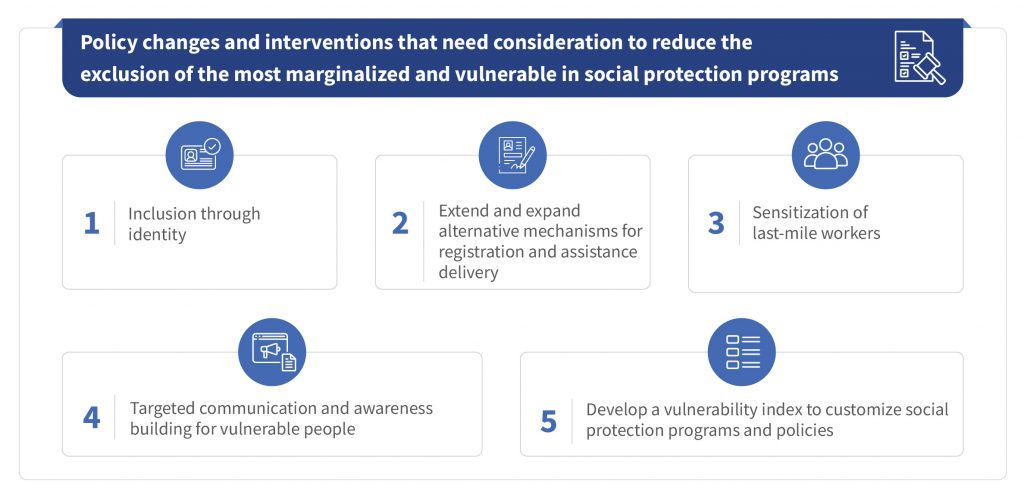
Developing countries have distinct national experiences regarding vulnerable populations and related laws and guidelines. They could consider developing customized interventions based on the following strategies and approaches.
1. Inclusion through identity
First, governments should ensure a foundational identity for the most vulnerable to roll out specific measures to bridge the last-mile gap in social protection for them. Micro-surveys, proofing through community workers, the local police, NGOs, and alternative mechanisms that permit registrations without birth certificates would open access to public services for vulnerable populations.
Further, vulnerable populations, such as homeless people and migrants, risk losing their documents as they lack a permanent place of residence. Governments should explore new technology approaches, such as decentralized identity systems, for easier recording and authentication of vulnerable groups.
2. Extend and expand alternative mechanisms for registration and assistance delivery
Vulnerable populations need flexibility in how they submit their documents and receive assistance. For such people, governments should allow flexibility to permit expanded, alternative options for them to prove their identity and eligibility. For instance, many states in India now provide doorstep assistance to differently-abled people, while Bangladesh has eased certain rules on providing identity to orphans.
3. Sensitization of last-mile workers
Last-mile workers include government officials and bank agents. They need to be sensitized to treat all applicants without bias against their gender, identity, income, or residential status. This can reduce the social stigma, fear, and resistance of vulnerable communities when they visit public offices. Such sensitization measures will further increase the interaction of such communities with the government, leading to better data collection and monitoring to expand social protection entitlements to the vulnerable communities
4. Targeted communication and awareness building for vulnerable people
Governments should adopt a bottom-up, community-based approach to deliver messages to vulnerable communities. Frontline workers, NGOs, community leaders, and labor associations should work to build awareness of the available assistance, entitlements, and rights of vulnerable and marginalized groups.
5. Develop a vulnerability index to customize social protection programs and policies
SPPs cannot be designed using a “one-size-fits-all” approach. Some population groups are more vulnerable than others. For instance, communities in Indonesia are prone to tsunamis, earthquakes, and volcanic eruptions that destroy homes and communities. The governments should develop a vulnerability index based on demographical, occupational, and climatic patterns to identify the most vulnerable people. For instance, governments should prioritize and include in the safety net ecosystem populations with disabilities, displaced people or those on the brink of losing shelter, people from highly remote areas, or people who live in disaster-prone areas.
Developing countries must take specific measures to build and strengthen their existing institutional structures to develop targeted policies for vulnerable populations. A focused approach will plug current gaps in accessing inclusive social protection and extend coverage of the vulnerable in the social protection system substantially by 2030.
[1] https://en.tempo.co/read/1468430/e-ktp-for-transgender-suara-kita-hopes-for-more-accessible-public-services
[2] https://en.tempo.co/read/1468430/e-ktp-for-transgender-suara-kita-hopes-for-more-accessible-public-services
Portability transactions of the Public Distribution System under One Nation One Ration Card: Why is portability working so well for Delhi?
In 2001, Rama and his family packed their meager possessions from their home in the Eastern Indian state of Bihar. They were on their way to the capital of Delhi, where Rama had found a job as a security guard. Yet they struggled with household expenses when they landed up in the capital city. Despite having a ration card under the National Food Security Act (NFSA), the family had to wait for many years to receive their ration entitlement from Delhi, since their ration card was issued in Bihar.
Till June 2022, Rama’s family had to spend a substantial portion of their income to make several long and expensive trips back to their village in Bihar every three months to avail of their rations. Moreover, they were worried their ration card would become invalid if it became dormant due to lack of use.
However, the One Nation One Ration Card (ONORC) program’s implementation changed their fate for the better, as it permits beneficiaries to obtain their rations from any fair price shop (FPS) across the country. In May 2022, a neighborhood dealer informed them that they could receive their rations in Delhi, thanks to the portability facility under the ONORC. Since then, they have successfully availed of their monthly ration in Delhi. Rama and his family no longer need to dedicate time and resources to visit their village or pay out of pocket for rations.
Rama’s story rings true for more than 330,000 interstate migrant NFSA beneficiaries who avail of their monthly ration entitlements from states other than their home.[1] These beneficiaries represent a minuscule percentage of interstate migrants in the country. As per the 2011 census, India has approximately 450 million internal migrants. While all these migrants do not need interstate portability services, a nationally representative study by MSC on ONORC pegs the potential for interstate portability transactions at 5 to 5.5 million per month.[2] Hence, the ONORC program is yet to achieve its objective of providing access to food, particularly to interstate migrant populations.
Delhi accounts for approximately 70% of the 330,000 interstate portability transactions. Indian states with larger migrant populations, such as Maharashtra and Gujarat, account for only 9% of interstate portability transactions. An FPS in Delhi conducts approximately 113 portability transactions per month compared to less than one in Maharashtra and Gujarat. Even comparable urban centers, such as Mumbai and Surat, which attract large migrant populations conduct only five and three transactions per FPS per month, respectively.[3] Despite a smaller migration population, Delhi ranks at the top with the most portability transactions conducted at FPSs.
So, what works well for Delhi?
In January 2023, MSC conducted qualitative research to identify reasons behind the wide variation in the uptake of interstate portability transactions among Indian states.[4] We analyzed three major aspects of ONORC, including stakeholder awareness, supply-side inclination, and system readiness—primarily the supply chain—to determine why Delhi had the most interstate portability transactions.
- Many FPSs, coupled with a dense migrant population, helped build awareness through word of mouth
Delhi has the highest number of FPSs and migrant population per sq km than other states, so awareness of interstate portability is higher (see Figure 1). Moreover, Delhi has the highest migrant population per FPS at 1,006 migrants per FPS compared to 150 for Maharashtra (see Figure 2). Although Mumbai has the highest migrant population among the major urban centers, it has only 575 migrants per FPS. The low density of migrants per FPS significantly reduces the propensity for solid word-of-mouth channels and, therefore, high awareness of portability. Most survey respondents were aware of ONORC. In Delhi, nearly every beneficiary was aware.


Beneficiaries across other states mentioned that many FPSs lack the ONORC program’s information, education, and communication (IEC) material. Any available IEC material is in the local language, which challenges migrants from other states who may not know it. Beneficiaries also mentioned that the IEC material lacks information on ONORC’s specific aspects. These aspects include interstate portability, the possibility of partial rations in both the home and destination states, and the ability to pick up the ration using the Aadhaar or ration card number for identification and authentication purposes rather than the physical ration card itself.
- Supply-side stakeholders create an enabling ecosystem
The government officials of the Civil Supplies Department of Delhi organized in-depth briefing sessions with FPS dealers to create local networks to circulate information among beneficiaries. FPS dealers in Delhi mentioned they had created WhatsApp groups on ration availability. FPS dealers in Thane also reported adopting the same approach, which may contribute significantly to the fact that Thane accounts for the highest number of interstate portability transactions in Maharashtra.
- System readiness, particularly in the supply chain, enhances efficient delivery
In all states except Telangana, FPS dealers reported a lack of provision for restocking once they had distributed the allotted quantity to beneficiaries. As a result, these FPS dealers had to deny rations to both home state and migrant beneficiaries who arrived in the later days of the cycle. However, in Delhi, the officials allow FPS dealers to request stock from nearby FPSs if additional rations are needed for distribution to migrant and home state beneficiaries. As a result, migrants in Delhi are not denied rations no matter at what point in the cycle they come for their rations.
Way forward
In light of the enabling factors uncovered in Delhi during our field research, MSC recommends a more targeted communication strategy to improve interstate portability transactions under ONORC in other states. This could take the form of a mixed communication strategy focused on beneficiaries, FPS dealers, and district-level officials. A high level of beneficiary awareness is among the major reasons why the uptake of interstate portability transactions worked well in Delhi.
For beneficiaries, targeted awareness campaigns should be promoted through the Prime Minister’s “Mann ki Baat” program to create awareness of ONORC and ensure large-scale impact. Further, the identification of migrant pockets to target bilingual communications and local-level awareness drives, such as announcements at railway and bus stations, will help strengthen word-of-mouth channels. These campaigns should emphasize specifics of portability, such as interstate and intrastate portability, partial rations, rations distributed through the Aadhaar or ration card number, and other salient features to facilitate successful interstate transactions.
States should replicate the IEC sessions conducted in Delhi to enhance stakeholder readiness on the supply side and sensitize district officials. In turn, these officials will then further the discourse with FPS dealers. These sessions should include information on the program’s salient features, portability, and the importance of creating local networks for communication. Dealers should also learn that denying rations to beneficiaries is not encouraged. Instead, they should engage with district officials to resolve system-related challenges or refer beneficiaries to neighboring FPS outlets.
Additional recommendations to ensure the ONORC program’s full use include a provision for FPS dealers to restock rations or the ability to request extra rations, as seen in Telangana, through the electronic point-of-sale devices (e-PoS) devices to make delivery more efficient for dealers. Coordination between states on ration delivery, equal treatment of beneficiaries, and resolution of IT challenges will help improve the ONORC program’s uptake, particularly interstate portability transactions
ONORC is an ambitious government program that strives to ensure food security for millions of migrants nationwide. However, four years after implementation, ONORC has some more road top cover before it can achieve its stated objective of providing migrant populations unfettered access to food rations. Inhibiting factors include low awareness on the demand side and lack of readiness on the supply side.
State governments can follow the above-suggested measures if they intend to play an integral role to ensure millions of migrants, much like Rama and his family, can reap the ONORC program’s benefits through information that is accurate, relevant, timely, and accessible.
[1] Portability transactions that occur in a state other than the home states of the beneficiaries are interstate transactions. The portability transactions that occur within the same (home) state but in an FPS other than to which the beneficiary is tagged are intrastate.
[2] MSC conducted a nationally representative study to assess ONORC’s implementation. We covered an overall sample of 5,735 citizens across 19 states.
[3] Mumbai and Surat have 2,905 and 816 FPSs, respectively.
[4] We conducted the research in five states namely Delhi, Maharashtra, Gujarat, Telangana, and Uttar Pradesh
What lessons can we learn from community-based adaptation approaches using Ag-techs to enhance smallholder farmers adaptive capacity?
CRAg VC’s East Africa chapter brings together AgTech startups, investors, NGOs, and donors to strengthen smallholder farmers’ resilience to climate change in the region.
The CRAg VC is an interactive collegial platform for promising tech-enabled startups, investors, practitioners, and growth-stage entities. The virtual club seeks to provide a platform to voice their thoughts and ideas to generate solutions, upscale them, and strengthen climate resilience for smallholder farmers.
The fourth edition of our climate resilience in agriculture, East Africa Chapter, was held on 30th March 2023. Our eminent panel of experts featured Sabdiyo Dido, the Head of Gender and Inclusiveness at Alliance for a Green Revolution in Africa (AGRA) and Timoth Wafula, an Agribusiness and climate change consultant. Their conversation focused on the following:
- The opportunities and challenges of using community-based adaptation approaches in East Africa to build the adaptive capacity of smallholders, and
- Emerging lessons from the successes and failures of community-based adaptation approaches that use AgTechs for climate-resilient agriculture in East Africa.
Click on the timestamps from the webinar stream to hear specific segments.
00:00 – 07:58 Welcome note and introduction of the topic to be discussed and panelists for the webinar by Anup Singh, Regional Head-Africa, MSC (MicroSave Consulting)
07:59 – 55:05 – A panel discussion: Conversation with the panelists, moderated by Anup Singh, Regional Head-Africa, MSC
Panelists:
- Sabdiyo Dido: Head of Gender and Inclusiveness at AGRA
- Timoth Wafula: Agribusiness and climate change consultant
08:37 – 15:03 Sabdiyo Dido: Head of Gender and Inclusiveness at AGRA, responds to question 1: What are the opportunities and challenges of using community-based adaptation approaches in East Africa to build the adaptive capacity of smallholders?
15:20 – 21:35 Timoth Wafula: Agribusiness and climate change consultant responds to question 1: What are the opportunities and challenges of using community-based adaptation approaches in East Africa to build the adaptive capacity of smallholders?
23:00 – 27:06 Sabdiyo Dido responds to QUESTION 2: How do we harness the local knowledge of farmers and combine it with digital technologies to create more climate smart adaptation technologies?
27:53 – 33:15 Timoth Wafula responds to question 2: Should tech-enabled solutions that farmers deploy and use in local communities be funded privately or by donors?
34:05 – 40:05 Sabdiyo Dido continues to respond to Question 2: How do we harness the local knowledge of farmers and combine it with digital technologies to create more climate-smart adaptation technologies? How can we make incentives more tangible for local communities?
40:10 – 48:09 The panelists respond to a round of questions from the audience
Question 1) A critical element of advancing community-based adaptation is a focus on learning and flexibility in how programming takes place at the local levels. Have you seen instances of greater willingness among funders to accept this need for flexibility and learning as critical elements of adaptation programming?
Question 2) Climate impacts can be variable and localized, even within countries and districts. How can we realistically generalize and replicate solutions even if they are developed within Africa?
Question 3) How can we ensure the benefits of CBA interventions are distributed equitably and that marginalized groups are not left behind?
48:33 – 55:04 The panelists share their concluding remarks
55:21 – 57:15 Anup Singh, MSC Africa – Regional Head at MSC, presents the concluding remarks.
